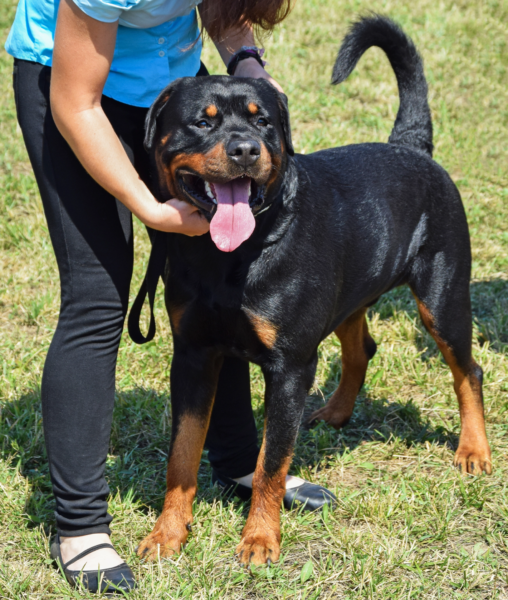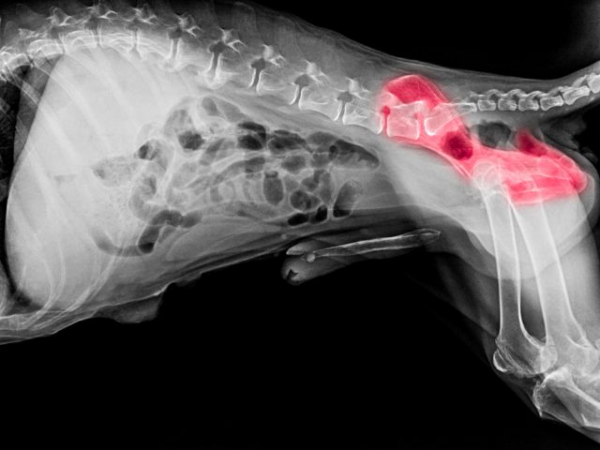Therapy dogs (whether Rottweilers or other breeds) come under the general heading of service dogs, a term which relates to all dogs that have been trained to perform a function that is useful to humans. Rottweilers can make excellent service dogs due to their high trainability, calm temperament and physical sturdiness. With effective training, many Rottweilers are capable of mastering a large variety of complex and specific tasks, which again makes the breed highly suitable for a number of service dog roles.
Individuals may require a service dogs for a large variety of reasons, and in reality no two people’s needs will be exactly alike. For this reason, it’s obviously vital that the characteristics of the service dog are carefully matched to the needs and preferences of the handler. In particular, Rottweilers are aptly matched to providing the following service dog roles:
- Therapy dog
- Mobility support animal for those with physical disability
- Police dog
- Guard dog
- Patrol dog
Rottweilers can also make excellent crisis response canines, due to their bravery, level-headed demeanor and physical strength. And whilst not every Rottie will made a good service dog, there’s certainly no reason to overlook the breed when it comes to training future service animals, particularly in areas where large size is a desirable trait.
If you are wondering can a Rottweiler be a service Dog? Click here to read more.
Planning to train your Rottweiler puppy? Read more.

What is a Therapy Dog?
Therapy service dogs are used to provide support, comfort and various other mental health benefits to a large variety of individuals. They are often handled by their owner when out on a community visit, and in fact many owners find this to be a really valuable means of giving back to their community. There are also a number of specific therapy dog training and deployment organizations in existence that send therapy dogs out alongside trained handlers.
Therapy dogs engage in activities such as visiting patients in hospitals to alleviate stress and boost moral; comforting victims of trauma or natural disasters; or facilitating improved social skills and task engagement in school children. Interacting with therapy dogs has been shown to reduce anxiety, lower blood pressure, and improve physical and psychological well-being [1].

Can a Rottweiler Be a Therapy Dog?
For many, the Rottweiler breed conjures visions of fierce and formidable guard dogs, amenable only to their handler or the person who they consider their “boss”. In reality, this is typically far from the truth: the (usually daft and affectionate) Rottie can make a truly exemplary companion dog, and often leads the way in canine excellence when it comes to cuddles – just ask a Rottweiler owner, or anybody who has had the pleasure of a 100lb Rottie therapy dog warming their heart (and – for those who are strong enough – their lap!)
When properly trained and socialized from a young age, most Rottweilers are not just the apple of their family members’ adoring eyes, but will also get along well with strangers and other dogs, too. So there’s no reason Rottweilers can’t also give back to their communities.

Can My Rottweiler Become a Therapy Service Dog?
Rottweiler owners who are interested in training their pet as a therapy service dog should first carefully consider if their dog has an appropriately friendly, tranquil and predictable temperament. It’s also necessary to obedience train your Rottweiler, as they need to have an excellent grasp of “human world” manners before they start to visit potentially vulnerable individuals.
Since Rottweilers were originally bred to be working dogs, they tend to respond readily to proper training that utilizes positive reinforcement methods (as well as treats…lots of treats!), so it isn’t usually too difficult to teach this breed how to behave politely. This is especially true if you make a start whilst your Rottweiler is still a puppy.
Sometimes though, even a rescue dog can make an incredible service dog; it’s not always necessary to get started when your Rottweiler is still a puppy. I happen to be well acquainted with a (truly wonderful) person – a veterinary colleague – who was able to train their rescued bully breed dog everything she needed to know to become the most fantastic therapy dog I have ever met. Sometimes, a dog’s best life starts halfway through!

Rottweiler Therapy Dog Roles
Rottweiler therapy dogs can be found bringing joy to a wide variety of individuals in an equally wide variety of settings, including nursing homes, schools, hospitals, rehabilitation centres, disaster areas and even prisons. Surprisingly, these big dogs can actually provide really good emotional support, as any experienced Rottweiler owner will surely vouch for!
What are Three Different Situations a Therapy Dog Might be Useful in?
Nursing homes
As anyone who’s ever grown close with a pet can attest to, interacting with animals can be exceptionally rewarding, alleviate loneliness and provide a great source of fun and entertainment. And as most dog owners will confirm, spending time with their pet can form a real highlight on an otherwise mundane day.
Individuals residing in nursing homes who might no longer be able to keep their own dog may well enjoy the opportunity to still enjoy the company of a visiting fur-legged friend from time to time. What’s more, the owners of therapy animals (who typically join for the ride) will likely also enjoy meeting nursing home residents and hearing tales (tails?) from a time gone by.
Schools
Therapy service dogs can enhance children’s wellbeing in a number of ways and of course, schools are one of the most obvious settings for this. Research suggests that therapy dogs can promote engagement with learning activities, and reduce both task avoidance and aggression in a classroom setting.
Promising early evidence suggests that dog-assisted reading programs can help children to improve their reading skills whilst simultaneously fostering more positive attitudes towards reading [2]. Dogs can also encourage social behaviors in kids, by acting as a sort of “social catalyst”, facilitating discussion, play and interaction.
Hospitals
Therapy service dogs can have a markedly positive impact within hospitals. Interacting with a dog is well known to reduce stress, and this can make a real difference when it comes to patient recovery. Psychological stress can slow wound healing and delay surgical recovery times [3], so of course it follows that if hanging out with a therapy dog reduces patient stress, it also very likely speeds up their recovery time.

What Skills Do Therapy Dogs Have?
Therapy service dogs have often undergone training to ensure that they are calm, well-behaved and gentle even when faced with diverse environments and when interacting with individuals who may not necessarily understand the best manner in which to approach a dog. However, a minority of therapy dogs simply have an incredibly calm, friendly temperament by default, as well as being socialized from a young age. Sometimes, this alone is sufficient to prepare a dog for a life of service as a therapy dog.
As we discussed earlier under “Can a Rottweiler be a Therapy Dog?”, you will need to make sure that you teach your Rottie good manners and that they have excellent obedience, since these are particularly large and powerful dogs, and they may at times be interacting with society’s more vulnerable groups.
Can a Rottweiler Be an Emotional Support Dog?
Emotional support animals (ESAs) have gained increased attention, and increased dramatically in popularity, in recent years. Technically, an ES dog is not really a type of service dog, or at least not accordingly to the legal definition. In order to qualify as an ESA, a pet needs to have been prescribed by a licensed mental health professional to an individual with a disabling psychological illness. The psychiatrist or other prescribing professional must have determined that the presence of the ESA is necessary to bolster the mental health of the patient.
Since an ES dog can be of any breed, you may wondering if your own Rottweiler would be eligible to become an ESA. The answer to this question is yes, a well trained Rottweiler could potentially make a fantastic ESA for their owner.
Emotional support dogs are different from psychiatric assistance dogs. The latter are a specialized type of service dog who have undergone training to assist their handler in coping with a psychiatric disability or a mental disability, such as obsessive-compulsive disorder, post-traumatic stress disorder or schizophrenia. Unlike “true” service dogs, ES dogs aren’t afforded such unlimited access to public places, and airlines do not have to accommodate them.

How Effective are Therapy Dogs?
A great body of evidence supports the notion that therapy dogs are effective for providing a sense of comfort and companionship, as well as for bringing about significant decreases in depression, anxiety and even pain. Not only are these benefits supported by qualitative data (such as that gathered from surveys), but quantitive, physical evidence also supports the effectiveness of therapy dogs:
Studies have consistently documented lower pulse rates, salivary cortisol (stress hormone) levels and blood pressure measurements in individuals after interacting with therapy dogs, compared to before the interaction.
The effectiveness of therapy service dogs is also reflected in the tangible changes documented in a number of study populations following therapy dog work. For example, significant improvements have been noted in the living profile scores (a measure of an individual’s ability to perform tasks paramount to independent daily function) and social contact scores for hospital inpatients with schizophrenia, as a result of therapy dog intervention. And for patients with post-traumatic stress disorder, a significant decrease in alcohol abuse use also been recorded as a result of therapy dog engagement [4].
Conclusion? A dog really can change your life.
If you’re wondering how often do dogs go to the vet? Read here.
References
- Gee, N.R., Rodriguez, K.E., Fine, A.H. and Trammell, J.P. (2021) ‘Dogs Supporting Human Health and Well-Being: A Biopsychosocial Approach’, Frontiers in Veterinary Science.
- Grove, C., Henderson, L., Lee, F. and Wardlow, P. (2021) ‘Therapy Dogs in Educational Settings: Guidelines and Recommendations for Implementation’, Frontiers in Veterinary Science, 8.
- Gouin, J-P. and Kiecolt-Glaser, J.K. (2012) ‘The Impact of Psychological Stress on Wound Healing: Methods and Mechanisms’, Immunology and Allergy Clinics of North America.
- Peel, N., Nguyen, K. and Tannou, C. (2023) ‘The Impact of Campus-Based Therapy Dogs on the Mood and Affect of University Students’, International Journal of Environmental Research and Public Health, 20 (6).











